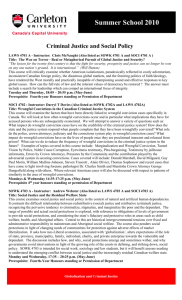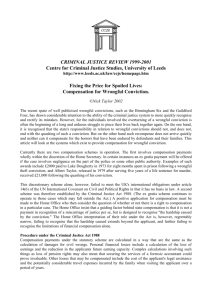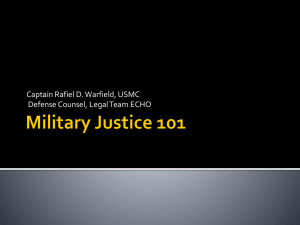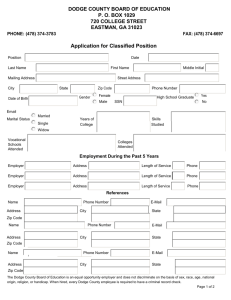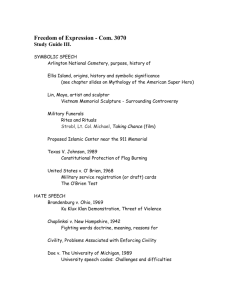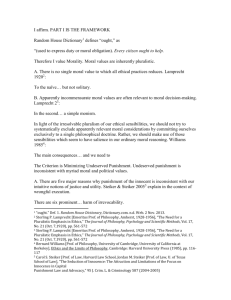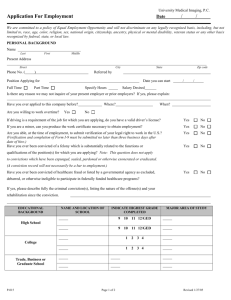Wrongful Conviction - nau.edu
advertisement
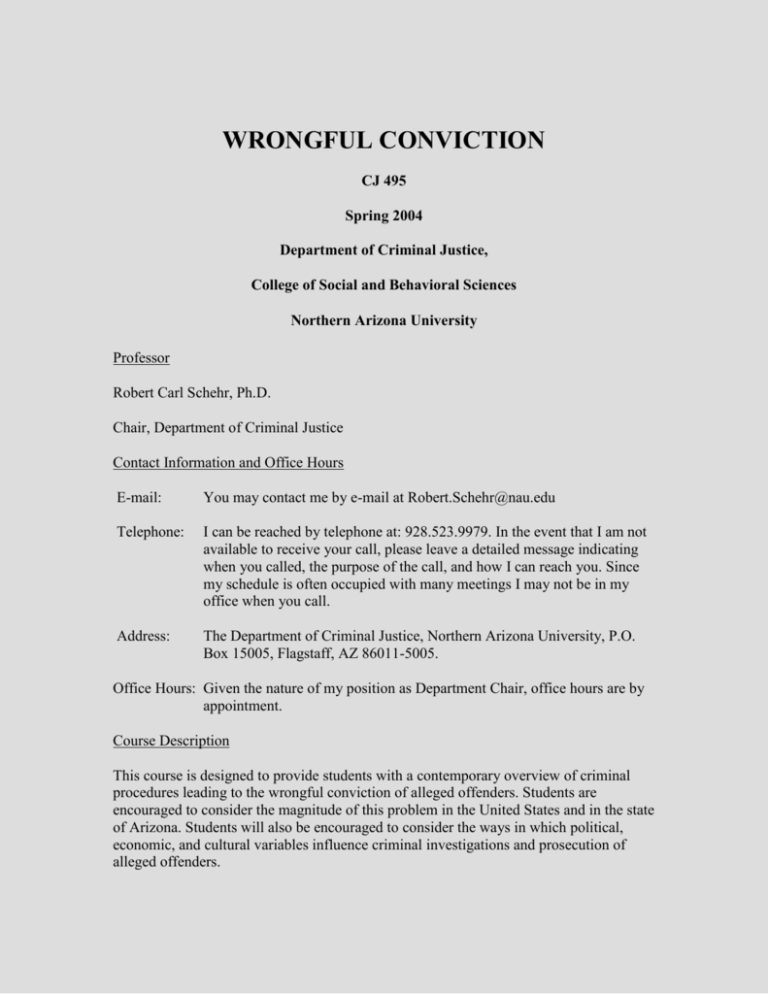
WRONGFUL CONVICTION CJ 495 Spring 2004 Department of Criminal Justice, College of Social and Behavioral Sciences Northern Arizona University Professor Robert Carl Schehr, Ph.D. Chair, Department of Criminal Justice Contact Information and Office Hours E-mail: You may contact me by e-mail at Robert.Schehr@nau.edu Telephone: I can be reached by telephone at: 928.523.9979. In the event that I am not available to receive your call, please leave a detailed message indicating when you called, the purpose of the call, and how I can reach you. Since my schedule is often occupied with many meetings I may not be in my office when you call. Address: The Department of Criminal Justice, Northern Arizona University, P.O. Box 15005, Flagstaff, AZ 86011-5005. Office Hours: Given the nature of my position as Department Chair, office hours are by appointment. Course Description This course is designed to provide students with a contemporary overview of criminal procedures leading to the wrongful conviction of alleged offenders. Students are encouraged to consider the magnitude of this problem in the United States and in the state of Arizona. Students will also be encouraged to consider the ways in which political, economic, and cultural variables influence criminal investigations and prosecution of alleged offenders. Course Goals and Objectives Upon completion of this course students should be prepared to: Critically analyze cases of wrongful conviction Thoroughly familiarize yourself with research materials associated with investigation of criminal cases. Thoroughly evaluate research materials leading to knowledge of contemporary issues constituting cases of wrongful conviction. Develop reading comprehension and writing skills. Thoroughly develop computer database search skills. Demonstrate competent knowledge of criminal procedure. Demonstrate awareness of the historical changes in criminal procedure. Demonstrate awareness of associations between criminal procedure and wrongful conviction. Demonstrate competent knowledge of sentencing practices, both contemporary and historical. Demonstrate awareness of the association between sentencing practices and wrongful conviction. Demonstrate awareness of the class, ethnic and gender components of wrongful conviction. Successfully identify pertinent research materials necessary to problem solve. Adequately utilize on-line research services. Course Policies Citation of other work and plagiarism: Please thoroughly familiarize yourself with both the Department of Criminal Justice and NAUs statements regarding plagiarism. Submitting work that is not your own, submitting work for this class that has been written for another class, and overly citing published references are each examples of plagiarism. Students identified as having plagiarized their work will receive a failing grade on the assignment and possibly the course. More serious ramifications may include University disciplinary action. You are encouraged to visit the following website to learn how to properly site your references: http:/jan.ucc.nau.edu/~kgk/HP/Index.htm Expectations of students in this class: Please be respectful of your classmates. Students are expected to behave as professionals. There will be no tolerance of unkind, inflammatory or otherwise hurtful speech. Students who violate standards of respectful interaction will initiate a process of reprimand that could lead to being withdrawn from the course. That said, students are encouraged to be forthright and honest. Disagreements are a natural and expected part of coming to understanding. The key is to focus disagreements on the points raised in your reading and on-line discussions of the course material. For an overview of the University’s general policy statement, please review the following: http://www.nau.edu/hp/dept/hpen/dept/nau_policy.html Students should be prepared to spend at least three hours per week on course assignments. In addition, for every hour spent on the class assignments, students are expected to spend two hours on reading assignments (about six hours). For nearly each week you will be expected to read two law review articles and one chapter from each book. Law review articles tend to run about 40 - 50 pages in length. Most often law review articles are constituted by 20-25 pages of actual text, followed by extensive notes and citations. Please make certain you get into the habit of reading the notes and citations in the law review articles. Key court decisions, explanations of technical language, and the like are often found in the notes. Course Summary Dates 1 1/141/18 Summary of Topics and Readings Module 1: Introduction to course; Brief discussion of theory, concepts and data pertaining to analysis of wrongful conviction. Roberts, P. C. "From Blackstone to Bentham: Why Wrongful Conviction is on the Rise." http://www.lewrockwell.com/roberts/roberts4.html Bedau, H. 2002. “Causes and Consequences of Wrongful Convictions: An Essay Review.” Judicature, 86 (2): 115-119. Warden, R. (forthcoming). “The Time-Honored Art of Convicting the Innocent.” Critical Criminology. Scheck and Neufeld: Intro 2-3 1/212/1 Radelet et al.: Intro Module 2: "What Is Wrongful Conviction?" Givelber, D. 1997. "Meaningless Acquittals, Meaningful Convictions: Do We Reliably Acquit the Innocent?" Rutgers Law Review 49: 1317-96. Griffin, L. 2001. "The Correction of Wrongful Convictions: A Comparative Perspective." American University International Law Review, 16: 1241. Dripps, D. 1999. "Miscarriages of Justice and the Constitution." Buffalo Criminal Law Review, 2: 635 Scheck and Neufeld: 1-34 4-5 2/42/15 Module 3: "Police and Prosecutorial Misconduct" Olson, R. 2002. “Miscarriage of Justice: A Cop’s View.” Judicature, 86 (2): 74-77. Martin, A. 1998. "Prosecutorial Misconduct." Georgetown Law Journal, 86: 1677. Gershman, B. 2001. "The Prosecutor's Duty To Truth." Georgetown Journal of Legal Ethics, 14: 309. Slobogin, C. 1996. "Testilying: Police Perjury and What To Do About It." Colorado Law Review, 67: 1037. Swedlow, K. (forthcoming). “Pleading Guilty v. Being Guilty: A Case for Broader Access to PostConviction DNA Testing.” Critical Criminology. 6-7 2/183/1 Radelet et al. 141-193 Module 4: "Eyewitness Testimony" Chemay, F. 1985. "Unreliable Eyewitness Evidence: The Expert Psychologist and the Defense in Criminal Cases." Louisiana Law Review, 45: 721. Mayer, C. 1994. "Due Process Challenges to Eyewitness Identification Based on Pretrial Photographic Arrays." Pace Law Review, 13: 815. Smith, S. 2001. "Eyewitness Identification: Postdictors of Eyewitness Errors: Can False Identification Be Diagnosed in the Cross-Race Situation?" Pscyhology, Public Policy and Law, 7: 153. Wells, G. “Mistaken Eyewitness Identification: Scientific Findings and the Case for Improvements in How Lineups are Conducted.” Loftus, E. 1995. “Remembering Dangerously.” Skeptical Inquirer, 19: 20-29. 8 3/43/8 Radelet et al.: 23-76 Case Presentations Distribute Exam 9 - 10 3/113/15 3/183/29 Spring Break Module 5: "False Confessions" Leo, R. and Drizin, S. “Proven False Confession Cases.” http://www.innocenceproject.org/docs/Master_List_False_Confessions.html. Cassell. P. 1999. "The Guilty and the 'Innocent': An Examination of Alleged Cases of Wrongful Conviction from False Confessions." Harvard Journal of Law and Public Policy, 22: 523-603. Johnson, G. 1997. "False Confessions and Fundamental Fairness: The Need For Electronic Recording of Custodial Interrogations." The Boston Public Interest Law Journal, 6: 719. White, W. 1997. "False Confessions and the Constitution: Safeguards Against Untrustworthy Confessions." Harvard Civil Rights-Civil Liberties Law Review, 32: 105. 11-12 4/14/12 Scheck and Neufeld: 78-106 Module 6: "The Use of Forensic Evidence In Wrongful Conviction Cases" Kiely, T. 2000. "The Houses of Deceits: Science, Forensic Science, and Evidence: An Introduction to Forensic Evidence." Land and Water Law Review, 35: 397. [Cole, S. 2002. chapter.] McDonald, R. 1998. "Juries and Crime Labs: Correcting the Week Links in the DNA Chain." American Journal of Law & Medicine, 24: 345. Saks, M. (forthcoming). “Forensic Science and Wrongful Convictions.” Critical Criminology. Radelet et al. 253-270 13 4/154/19 Scheck and Neufeld: 35-40; 158-171; 107-125 Module 7: "Wrongful Conviction and the Death Penalty" Liebman, J. 2002. “Rates of Reversible Error and the Risk of Wrongful Execution.” Judicature, 86 (2): 78-82. Bright, S. 1994. “COUNSEL FOR THE POOR:THE DEATH PENALTY NOT FOR THE WORST CRIME BUT FOR THE WORST LAWYER.” Yale Law Journal, 103:1835. Bright, S. 2000. “Will the Death Penalty Remain Alive in the Twenty-First Century: International Norms, Discrimination, Arbitrariness and the Risk of Executing the Innocent.” Wisconsin Law Review, 2001 (1): 1. Arizona Capital Case Commission Report: Office of the Attorney General (2001). http://www.ag.state.az.us/CCC/IntRpt.PDF 14 4/224/26 Review of the Death Penalty Process in Arizona (2001) http://www.caadp.org/ccc/bortneretal2texttables.pdf (You will be prompted for a password, click "Cancel," wait a few seconds, and the file will appear.) Module 8: "Race/Ethnicity and Judicial Decision-Making" Johnson, S. 1988. "Unconscious Racism and Criminal Law." Cornell Law Review, 73: 1016. Earle, E. 1992. "Banishing the Thirteenth Juror: An Approach to the Identification of Prosecutorial Racism." Columbia Law Review, 92: 1212. Alfieri, A. 2001. "Race Prosecutors, Race Defenders." Georgetown Law Journal, 89: 2227. 15 4/295/3 Scheck and Neufeld: 193-210 Module 9: "Ineffective Assistance of Counsel" Bright, S. 2003. “Turning Celebrated Principles Into Reality.” The Champion, 27 (1): 6-12. Levinson, J. 2001. "Don't Let Sleeping Lawyers Lie: Raising the Standard for Effective Assistance of Counsel." American Criminal Law Review, 38: 147. Beeman, M. 2001. "Fulfilling the Promise of the Right to Counsel: How to Ensure that Counsel is Available to Indigent Defendants 1) Upon Questioning Following Arrest, and 2) Following Probable Cause Determination and Awaiting Indictment." New England Journal on Criminal and Civil Confinement, 27: 27. 16 5/6-510 Scheck and Neufeld: 183-192 Module 10: “What Can Be Done?” Schehr, R. and Sears, J. (forthcoming). “Innocence Commissions: Due Process Remedies and Protection for the Innocent.” Journal of Contemporary Criminal Justice. Schehr, R. (forthcoming). “Innocence Projects as a New Civil Rights Movement.” Critical Criminology. Innocence Protection Act. 2001. Prepared by the Office of Congressman William D. Delahunt. Constantine, L. et.al. 2001. “Model Prevention and Remedy of Erroneous Convictions Act.” Arizona State Law Journal, 665. Report of the Governor’s Commission on Capital Punishment. 2002. State of Illinois Press. Finals Assignments and Evaluation Methods General Procedures and Time Limits Please adhere to the deadlines identified for submission of each assignment. Should you complete an assignment ahead of time, submit it early. Late submissions will receive a 5 pt. deduction each day beyond the due date. There will be no opportunities to submit work for extra credit. Evaluation System Exams (2): 100 pts. Each. Exams are written in take-home essay format. Case Study Analysis (1): 100 pts. (Instructor = 60 points; Student Group Members = 40 points). A word about Peer Evaluation – Your group projects will include peer evaluation of each member and their participation toward completion of the project. Peer evaluations are anonymous and will be based on a series of questions developed to determine level and quality of participation. Students will have a maximum of 10 points they may credit to each member of the group. More will be said about peer evaluation as the semester proceeds. Group Composition – To the extent possible, each group will be comprised of five members. Information pertaining to the case studies is forthcoming Grade Scale Total Points = 300 A = 270 – 300 B = 240 – 269 C = 210 – 239 D = 180 – 209
